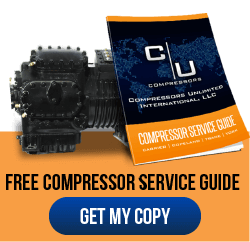A commercial compressor does most of the mechanical work for the cooling loop to be completed. Although the result is cool air or a refrigerated space, the system itself needs to manage plenty of waste heat. This heat threatens to raise the operating temperature.
Overheating is one of the most serious threats to any commercial compressor. Luckily, there are options for keeping the system cool. Dedicated cooling components meet this need. The systems are integrated into the compressor, but they can be replaced or upgraded.
The cooling system provides two functions, both essential:
- It ensures the air entering the compressor is at the right temperature
- It helps manage the working temperature of the compressor unit
There are two main types of cooling systems: Air-cooled and water-cooled.
The Two Types of Compressor Cooling Systems
Having the right cooling system in place is critical for keeping your system running. A water-cooled approach is the most powerful, but an air-cooled system is less resource-heavy. Let’s take a look at the differences between the two:
1. Air Cooled Compressor Cooling
Generally, an air-cooled system relies on a fan to force air across cooling fins. Cooling fins are located all around the outside of the unit, providing more surface area for the heat to escape. Airflow over the fins picks up heat and carries it away.
An air-cooled system is great for almost any light-duty application. They’re especially efficient in areas where outdoor temperatures remain moderate throughout the year. For hot climates and heavy-duty applications, you will need a more potent solution – that usually means water cooling.
2. Water Cooled Compressor Cooling
There are two unique categories of water cooling systems for compressors. The system can be designed to be open or closed. In effect, it can use circulating water or be hooked up to an external water source. This means choosing the right system for the job at hand is even more vital.
In a closed water cooling system, the system is filled to capacity with water. The water is then allowed to circulate all through the system while it is in operation. As the water flows through a prescribed path, it takes the heat to a heat exchanger positioned outside the unit.
The heat exchanger, on the other hand, adds a second layer of cooling to the process. It usually has the same kind of air cooling system as described above, using a fan and a set of carefully placed fins. A combination of both methods allows for efficient management of a very large amount of heat.
Heated water is pulled away from the compressor unit and pushed through a spray nozzle that leads down into an isolated cavity. The process of separating water into droplets and spraying it out greatly accelerates the cooling. The cooled water is then funneled onto its next destination.
Once the water is completely cooled, it re-enters the compressor unit and continues another circuit.
In an open water cooling system, things look a bit different. A system where water doesn’t recirculate requires a hose or other water source that connects directly to the cooling system. As the compressor runs, it draws fresh water from the hose. The water simply drains off or evaporates as it passes through.
Choosing the Right Type of Cooling System
As with so many things in the world of compressors, bigger isn’t always better. A cooling system must be of the right size to deliver the required level of cooling while remaining efficient. A small cooling system might not support the required temperatures, while a larger one can be wasteful.
The cost of operating the compressor is just one aspect to be aware of as you compare cooling options. Also, look at the amount of space you have available and whether it is possible to easily connect your system to running water, a necessity if you want to go with an open design.
If you’ve had overheating problems with compressors in the past, be sure to get down to the root of the issue before you introduce a new compressor. Electrical wiring damage, indoor air pollution, and other factors can contribute to overheating. If these are not resolved, your new compressor will still be vulnerable to an early failure, though a good cooling system may sometimes prolong its life.
The size of the cooling system can be a bottleneck on the size of the compressor and the level of demand it can handle. For personalized advice about precise system sizing, contact experts in commercial HVAC compressor engineering.
Also consider reducing your cost and turnaround time with a remanufactured commercial compressor, which offers “like new” performance at deep discounts. You can choose the Carrier 06ET275360, Carrier 5H80, Copeland 4DK2500TSK, Copeland 3DS3A150ETFC, Trane CHHN60, Trane CHHB100, and many more for these types of systems.












